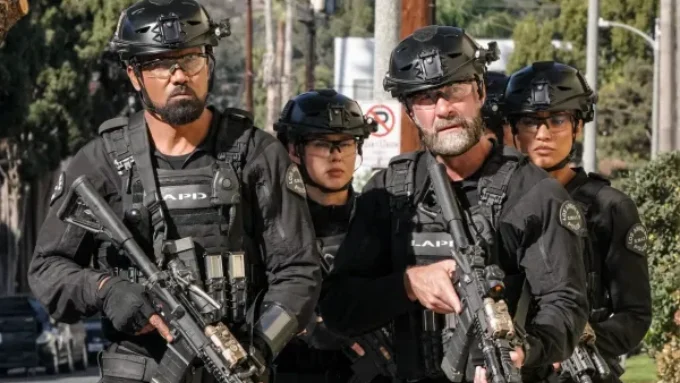
What Happens to Claude Fornier After His Arrest in S.W.A.T?
After Claude Fornier surrenders to Hondo and the S.W.A.T. team at Delacosta High School, he faces serious legal consequences for his actions. Though the episode ends with his arrest, we can piece together what likely happens to him based on the crimes he committed.
Following his arrest, Fornier is taken to the police station for processing. As a former police officer who killed two fellow officers and injured others, he is held without bail due to the severity of his crimes and the risk he might try to harm others. During this time, he is kept separate from other inmates because of his former status as a police officer, which could make him a target.
The district attorney charges Fornier with multiple serious crimes. These include two counts of first-degree murder for the deaths of Officers Rivera and Chalke, attempted murder for shooting Officer Butrosian (who survived) and Nelson Phillips, kidnapping Dr. Wendy, and several weapons charges. As a former officer who planned these attacks, Fornier faces enhanced penalties that make his situation even more serious.
In the weeks after his arrest, Fornier undergoes a mental health evaluation to determine if he is fit to stand trial. Given his clear planning of the crimes and his understanding of right and wrong (shown when he ultimately surrendered), he is likely found competent to face trial. However, his defense attorney probably argues that his mental state was affected by the trauma and stress from the Delacosta school shooting and losing his job.
During pretrial hearings, Fornier’s defense team tries to get some evidence thrown out, but the case against him is strong. There are witnesses who saw him, physical evidence like the rifle he dropped during the chase, and his own confession when he took Dr. Wendy hostage. The prosecution offers a plea deal to avoid a lengthy trial, but whether Fornier accepts it depends on advice from his lawyers.
If Fornier goes to trial, the proceedings receive significant media attention because of the high-profile nature of the case—a former police officer targeting his colleagues over a controversial school shooting response. The trial includes testimony from Dr. Wendy about Fornier’s mental state, surviving victims like Officer Butrosian and Nelson Phillips, and expert witnesses who discuss police protocols during active shooter situations.
Given the overwhelming evidence against him, Fornier is found guilty on most or all charges. At his sentencing hearing, family members of the officers he killed give impact statements about their loss. Fornier also has a chance to speak, likely expressing remorse while explaining how he felt betrayed by the department and his fellow officers after the school shooting.
The judge sentences Fornier to life in prison without the possibility of parole for the murder charges. He receives additional years for the attempted murders and kidnapping, though these sentences run concurrently with his life sentence. Because of his crimes against law enforcement and his status as a former officer, Fornier serves his time in a special housing unit or protective custody to prevent attacks from other inmates.
While in prison, Fornier likely participates in mental health treatment programs. His case becomes a talking point within law enforcement about the importance of proper support for officers involved in traumatic incidents like school shootings. Some police departments use his story as a case study to improve their psychological screening and support services.
Years after his conviction, Fornier might give interviews to researchers or journalists about what led him to commit his crimes. These become part of studies on preventing similar incidents and understanding the psychological impact of high-stress police work. The Delacosta school shooting and Fornier’s subsequent crimes lead to changes in police training, particularly around active shooter situations and officer mental health support.
For the officers and families affected by Fornier’s actions, closure comes slowly. The surviving victims like Officer Butrosian face a long recovery, both physically and emotionally. Dr. Wendy continues her work with the department but carries the weight of her experience with Fornier, wondering if she could have done more to prevent his breakdown.
The S.W.A.T. team members, especially Hondo who talked Fornier into surrendering, occasionally think about the case during difficult moments in their careers. They remember it as a stark reminder of how trauma can affect anyone in law enforcement if left unaddressed. For them, the case reinforces the importance of supporting each other through the challenges of their dangerous profession.
Fornier’s story ultimately becomes a cautionary tale within the LAPD about the consequences of not properly addressing officer trauma and the dangers of letting institutional pressures override proper officer support after critical incidents.


